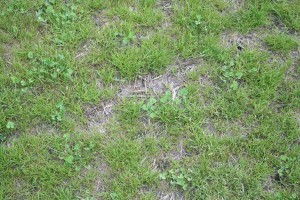
Let me count the ways. First, a little perspective – this is the front lawn of a school that was just renovated. There was little money to invest in the lawn and even less to help the struggling lawn.
Problem #1: Compaction
This area was the staging area for the equipment and material storage during school renovations, so we know right off the bat that this area is compacted.
The Fix: Aeration
To relieve compaction, a core aerator can be used to punch holes in the turf, pulling out soil cores. The holes left behind provide space for air and water movement and root growth within the soil. If the school does not own an aerator, a small one can usually be rented at a local hardware store for a nominal fee. In the NY Capital region, I am able to rent an aerator for $40 for four hours and $80 a day.
Problem #2: Excess Straw

We can still see a significant amount of straw that was put down to protect the seeds and seedlings. At this stage, however, the straw is actively competing against the turf. Soil bacteria need nitrogen to decompose the straw – nitrogen that is also needed by the grass.
The Fix: Feed Right
Typically you would wait until the fall to get the most out of your fertilizer, but in this case, the Cornell Turf Team recommends an inexpensive, quick-release nitrogen fertilizer, such as urea, to increase nitrogen levels in the soil and make it available to the struggling grass. A soil test will determine whether other nutrients are also needed.
Problem #3: Less Than Ideal Growing Conditions
On top of compacted soil, this area has no irrigation. In the Northeast you can have a lawn without irrigation, but you want to make sure to give the grass every other advantage.
The Fix: Mow Right
We recommended raising the mowing height – to allow for more and deeper root growth. Also, be sure that mower blades are sharp. Dull blades shred, not cut, leaf blades, creating more stress.
(Likely) Problem #4: The Wrong Seed
We can’t be sure, but it is a likely that the area was seeded with an inexpensive contractor mix. Choosing the right grass for the site is one of the most important steps you can take to solve a number of problems.
The Fix: Overseeding
Given the lack of financial resources, it is probably best to wait until the more ideal late summer or early fall before reseeding bare areas. To help choose what turfgrass seed to choose, visit the Cornell Turfgrass website on choosing grass varieties.
Bare areas within weak turfgrass stands are susceptible to erosion and are practically an invitation for weeds to fill the void. The Child Safe Playing Fields Act prevents the application of an herbicide to either prevent or control weeds on school grounds, so providing a good growing environment to maintain healthy grass is imperative. The above fixes, and more, can be found in detail in Lawn Care: The Easiest Steps to an Attractive Environmental Asset.